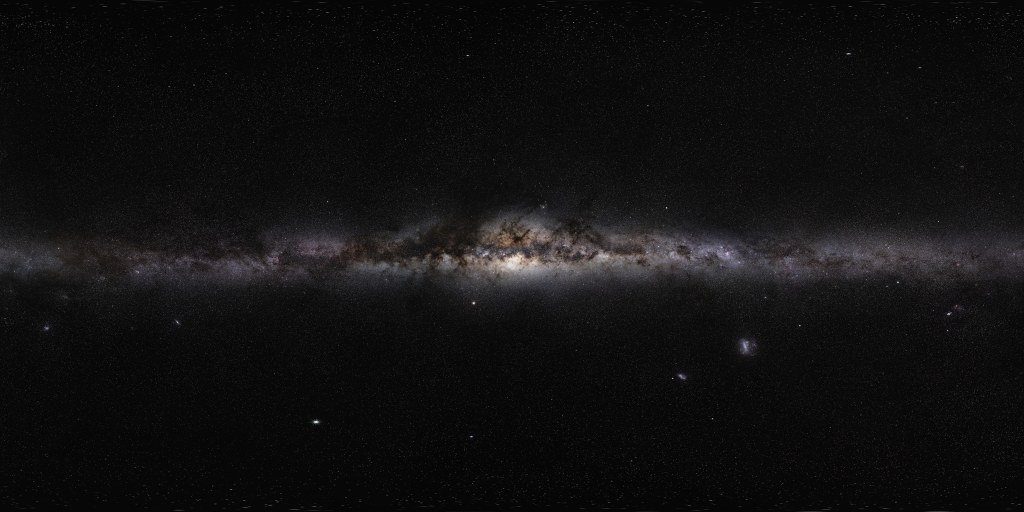Immerse In The Breathtaking Panorama Of The Milky Way – Experience The Cosmos Like Never Before!
Panorama of the Milky Way: Unlocking the Secrets of Our Galaxy
Introduction
Hello, Good Readers!
1 Picture Gallery: Immerse In The Breathtaking Panorama Of The Milky Way – Experience The Cosmos Like Never Before!
Welcome to a journey through the vast expanse of the universe. Today, we will embark on an exploration of the breathtaking panorama of the Milky Way, our home galaxy. Join us as we delve into the mysteries of the cosmos and discover the wonders that lie beyond our reach.

Image Source: eso.org
The Milky Way, a barred spiral galaxy, is a mesmerizing sight that has captivated astronomers and stargazers for centuries. Its beauty and complexity have inspired countless works of art and scientific endeavors. In this article, we will unravel the secrets of the Milky Way and shed light on its fascinating characteristics.
So, fasten your seatbelts and get ready to embark on a celestial adventure that will leave you in awe of the grandeur of the universe.
What is the Milky Way? 🌌
The Milky Way is a colossal structure consisting of billions of stars, dust, gas, and other celestial objects. It stretches across a distance of approximately 100,000 light-years, captivating observers with its spiral arms and illuminated center.
🔍 Did you know? The name Milky Way originates from the Ancient Greek word galaxias kyklos, meaning milky circle. This term was used by the Greeks to describe the band of light they observed in the night sky.
The Milky Way is part of a galaxy group known as the Local Group, which also includes the Andromeda Galaxy and numerous other smaller galaxies. Within the Milky Way, there are over 200 billion stars, each with its own unique story to tell.
The structure of the Milky Way consists of a central bulge surrounded by a disk composed of spiral arms. These arms, resembling a giant cosmic pinwheel, are made up of young stars, gas, and dust. At the center of the galaxy lies a supermassive black hole, which plays a vital role in shaping its structure and dynamics.
Who Discovered the Milky Way? 🌟
The first recorded mention of the Milky Way dates back to ancient times. However, the true nature of this celestial phenomenon was not fully understood until the scientific revolution of the 17th century.
🔍 Did you know? The Greek philosopher Democritus was one of the first to propose that the Milky Way consisted of numerous stars. He believed that these stars were too faint to observe individually, giving rise to the appearance of a continuous band of light.
In the 1600s, astronomers such as Galileo Galilei and Johannes Kepler made groundbreaking observations and discoveries related to the Milky Way. Galileo’s revolutionary use of the telescope allowed him to discern individual stars within the Milky Way and identify it as a conglomeration of countless celestial bodies.
Since then, astronomers from around the world have dedicated their lives to unraveling the secrets of our galaxy, using advanced telescopes and technology to explore the mysteries that lie within.
When Can We Observe the Milky Way? ✨
The best time to observe the Milky Way is during the darkest nights, away from light pollution. Ideally, this occurs when the moon is absent or in its crescent phase, allowing for optimal visibility of the stars and the galactic band.
🔍 Did you know? The Milky Way is visible to the naked eye, but its full glory can be appreciated in locations with minimal light pollution, such as remote areas, national parks, and observatories.
Seasonal variations also play a role in visibility, as the galactic center appears more prominently during certain times of the year. In the northern hemisphere, the summer months offer the best opportunities to witness the Milky Way in all its splendor.
So, mark your calendars and plan a stargazing excursion to witness the awe-inspiring beauty of the Milky Way firsthand.
Where is the Milky Way Located? 🌏
The Milky Way is located within the Virgo Supercluster, an enormous collection of galaxies that spans over 110 million light-years. Our galaxy can be found in the outer reaches of the Local Group, nestled between the Andromeda Galaxy and the Triangulum Galaxy.
🔍 Did you know? Our solar system is situated on one of the spiral arms of the Milky Way, approximately 27,000 light-years from its center.
The exact position of the Milky Way in the night sky varies depending on the observer’s location and the time of year. However, it is generally visible as a luminous band stretching across the celestial sphere.
So, next time you gaze up at the stars, remember that you are a part of something much greater – a vast cosmic tapestry known as the Milky Way.
Why is the Milky Way Significant? 🌠
The Milky Way holds immense significance for astronomers and scientists alike. Its study provides crucial insights into the formation and evolution of galaxies and sheds light on the fundamental processes that shape our universe.
🔍 Did you know? The Milky Way is believed to be over 13 billion years old, making it one of the oldest galaxies in the universe.
By examining the composition, dynamics, and interactions of the Milky Way, scientists can unravel the mysteries of dark matter, black holes, star formation, and the origins of life itself. The galaxy serves as a cosmic laboratory, enabling us to deepen our understanding of the cosmos.
Furthermore, the Milky Way has captured the imagination of countless generations, inspiring us to explore the unknown and question our place in the universe. It serves as a reminder of the vast possibilities that lie beyond the confines of our planet.
How Can We Explore the Milky Way? 🚀
Exploring the vastness of the Milky Way poses numerous challenges due to its immense size and distance from Earth. However, scientists have devised innovative methods to study our galaxy and unlock its secrets.
1. Telescopes: Advanced telescopes, both ground-based and space-based, have enabled astronomers to observe distant stars, galaxies, and nebulae within the Milky Way. These telescopes capture light across various wavelengths, allowing us to study different aspects of the galactic panorama.
2. Space Missions: NASA and other space agencies have launched missions specifically targeting the Milky Way. These missions, such as the Gaia satellite and the upcoming James Webb Space Telescope, provide high-resolution data to create detailed maps of our galaxy and its contents.
3. Radio Astronomy: Radio telescopes are used to detect and analyze radio waves emitted by celestial objects. By studying the radio emissions from the Milky Way, scientists can gain insights into its structure, magnetic fields, and the presence of cosmic phenomena.
4. Computer Simulations: Complex computer simulations are used to model the formation and evolution of galaxies, including the Milky Way. These simulations help scientists test theories and hypotheses, providing valuable insights into the processes that shape the cosmos.
Through these methods and ongoing research, scientists are constantly expanding our understanding of the Milky Way, unraveling its mysteries, and paving the way for future discoveries.
Advantages and Disadvantages of Observing the Milky Way 🌠
1. Advantages:
– Awe-Inspiring Beauty: Observing the Milky Way offers a chance to witness the breathtaking beauty of our galaxy, sparking a sense of wonder and awe.
– Scientific Insights: Studying the Milky Way provides valuable data and insights into the formation, evolution, and dynamics of galaxies, contributing to our understanding of the universe.
– Inspirational and Educational: The Milky Way inspires future generations to pursue careers in science, astronomy, and space exploration, fostering curiosity and innovation.
2. Disadvantages:
– Light Pollution: Observing the Milky Way becomes challenging in areas with high levels of light pollution, obscuring the visibility of stars and other celestial objects.
– Limited Accessibility: Due to Earth’s atmosphere and the galaxy’s vast size, certain areas of the Milky Way may be inaccessible for detailed observation.
– Technological Limitations: Despite advancements in technology, our current instruments and telescopes can only provide limited information about the intricacies of the Milky Way.
Frequently Asked Questions about the Milky Way 🌌
1. How was the Milky Way formed?
The Milky Way formed through the gravitational collapse of a giant molecular cloud, which led to the accumulation of gas, dust, and stars. Over billions of years, these materials coalesced to form the structure we observe today.
2. Are there other galaxies similar to the Milky Way?
Yes, there are billions of galaxies in the universe, many of which are similar in structure to the Milky Way. These galaxies exhibit a variety of shapes, sizes, and characteristics.
3. Can we leave the Milky Way?
With our current technology, leaving the Milky Way is beyond our reach. The immense distances and challenges involved make intergalactic travel a formidable task.
4. Are there habitable planets within the Milky Way?
Scientists have discovered numerous exoplanets within the Milky Way that may possess conditions suitable for life. However, further exploration and research are required to determine their habitability.
5. Will the Milky Way collide with another galaxy?
Yes, the Milky Way is on a collision course with the Andromeda Galaxy, our nearest galactic neighbor. The collision, which will occur billions of years from now, will reshape both galaxies and create a new cosmic entity.
Conclusion: Embrace the Majesty of the Milky Way ✨
As we conclude our journey through the panorama of the Milky Way, we invite you to cherish the beauty and significance of our galaxy. The Milky Way serves as a reminder of the vastness and complexity of the universe, igniting our curiosity and inspiring us to reach for the stars.
So, next time you gaze up at the night sky, take a moment to appreciate the celestial spectacle above you. Let the wonders of the Milky Way ignite your imagination and propel you towards new horizons of knowledge and discovery.
Final Remarks: Discover the Universe Within You 🌌
As we explore the vastness of the cosmos, it is important to remember that the wonders of the universe also reside within us. The same elements that form stars and galaxies are present in our bodies, connecting us to the cosmic dance of creation.
Let the panorama of the Milky Way be a reminder of our shared origins and the boundless possibilities that lie within each and every one of us. Embrace the mysteries of the universe, explore the depths of your imagination, and let the light of knowledge guide your journey.
This post topic: Panorama


